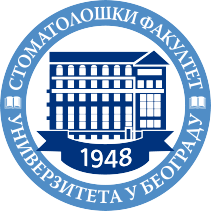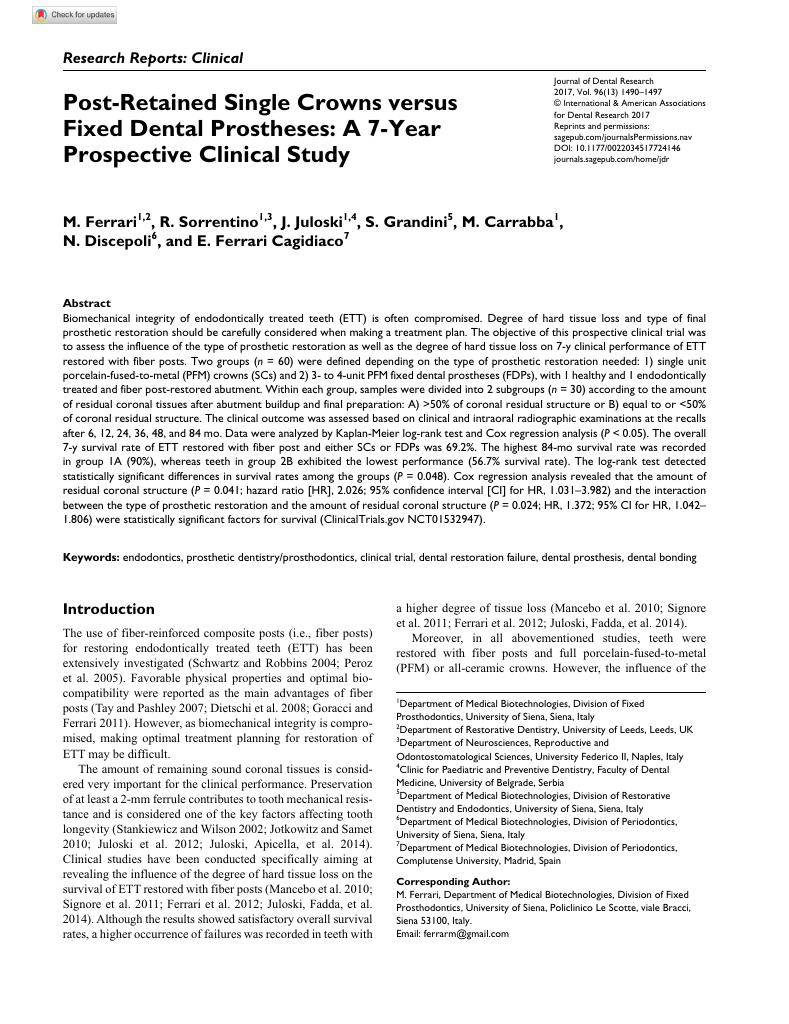Post-Retained Single Crowns versus Fixed Dental Prostheses: A 7-Year Prospective Clinical Study
2017
Autori
Ferrari, Marco
Sorrentino, Roberto
Juloski, Jelena

Grandini, Simone

Carrabba, Michele

Discepoli, N.

Ferrari Cagidiaco, E.
Članak u časopisu (Objavljena verzija)

Metapodaci
Prikaz svih podataka o dokumentuApstrakt
Biomechanical integrity of endodontically treated teeth (ETT) is often compromised. Degree of hard tissue loss and type of final prosthetic restoration should be carefully considered when making a treatment plan. The objective of this prospective clinical trial was to assess the influence of the type of prosthetic restoration as well as the degree of hard tissue loss on 7-y clinical performance of ETT restored with fiber posts. Two groups (n = 60) were defined depending on the type of prosthetic restoration needed: 1) single unit porcelain-fused-to-metal (PFM) crowns (SCs) and 2) 3- to 4-unit PFM fixed dental prostheses (FDPs), with 1 healthy and 1 endodontically treated and fiber post-restored abutment. Within each group, samples were divided into 2 subgroups (n = 30) according to the amount of residual coronal tissues after abutment buildup and final preparation: A) >50% of coronal residual structure or B) equal to or lt 50% of coronal residual structure. The clinical outcome was as...sessed based on clinical and intraoral radiographic examinations at the recalls after 6, 12, 24, 36, 48, and 84 mo. Data were analyzed by Kaplan-Meier log-rank test and Cox regression analysis (P lt 0.05). The overall 7-y survival rate of ETT restored with fiber post and either SCs or FDPs was 69.2%. The highest 84-mo survival rate was recorded in group 1A (90%), whereas teeth in group 2B exhibited the lowest performance (56.7% survival rate). The log-rank test detected statistically significant differences in survival rates among the groups (P = 0.048). Cox regression analysis revealed that the amount of residual coronal structure (P = 0.041; hazard ratio [HR], 2.026; 95% confidence interval [CI] for HR, 1.031-3.982) and the interaction between the type of prosthetic restoration and the amount of residual coronal structure (P = 0.024; HR, 1.372; 95% CI for HR, 1.042-1.806) were statistically significant factors for survival.
Ključne reči:
endodontics / prosthetic dentistry/prosthodontics / clinical trial / dental restoration failure / dental prosthesis / dental bondingIzvor:
Journal of Dental Research, 2017, 96, 13, 1490-1497Izdavač:
- Sage Publications Inc, Thousand Oaks
DOI: 10.1177/0022034517724146
ISSN: 0022-0345
PubMed: 28771388
WoS: 000415925000004
Scopus: 2-s2.0-85034762666
Kolekcije
Institucija/grupa
Stomatološki fakultetTY - JOUR AU - Ferrari, Marco AU - Sorrentino, Roberto AU - Juloski, Jelena AU - Grandini, Simone AU - Carrabba, Michele AU - Discepoli, N. AU - Ferrari Cagidiaco, E. PY - 2017 UR - https://smile.stomf.bg.ac.rs/handle/123456789/2211 AB - Biomechanical integrity of endodontically treated teeth (ETT) is often compromised. Degree of hard tissue loss and type of final prosthetic restoration should be carefully considered when making a treatment plan. The objective of this prospective clinical trial was to assess the influence of the type of prosthetic restoration as well as the degree of hard tissue loss on 7-y clinical performance of ETT restored with fiber posts. Two groups (n = 60) were defined depending on the type of prosthetic restoration needed: 1) single unit porcelain-fused-to-metal (PFM) crowns (SCs) and 2) 3- to 4-unit PFM fixed dental prostheses (FDPs), with 1 healthy and 1 endodontically treated and fiber post-restored abutment. Within each group, samples were divided into 2 subgroups (n = 30) according to the amount of residual coronal tissues after abutment buildup and final preparation: A) >50% of coronal residual structure or B) equal to or lt 50% of coronal residual structure. The clinical outcome was assessed based on clinical and intraoral radiographic examinations at the recalls after 6, 12, 24, 36, 48, and 84 mo. Data were analyzed by Kaplan-Meier log-rank test and Cox regression analysis (P lt 0.05). The overall 7-y survival rate of ETT restored with fiber post and either SCs or FDPs was 69.2%. The highest 84-mo survival rate was recorded in group 1A (90%), whereas teeth in group 2B exhibited the lowest performance (56.7% survival rate). The log-rank test detected statistically significant differences in survival rates among the groups (P = 0.048). Cox regression analysis revealed that the amount of residual coronal structure (P = 0.041; hazard ratio [HR], 2.026; 95% confidence interval [CI] for HR, 1.031-3.982) and the interaction between the type of prosthetic restoration and the amount of residual coronal structure (P = 0.024; HR, 1.372; 95% CI for HR, 1.042-1.806) were statistically significant factors for survival. PB - Sage Publications Inc, Thousand Oaks T2 - Journal of Dental Research T1 - Post-Retained Single Crowns versus Fixed Dental Prostheses: A 7-Year Prospective Clinical Study VL - 96 IS - 13 SP - 1490 EP - 1497 DO - 10.1177/0022034517724146 ER -
@article{
author = "Ferrari, Marco and Sorrentino, Roberto and Juloski, Jelena and Grandini, Simone and Carrabba, Michele and Discepoli, N. and Ferrari Cagidiaco, E.",
year = "2017",
abstract = "Biomechanical integrity of endodontically treated teeth (ETT) is often compromised. Degree of hard tissue loss and type of final prosthetic restoration should be carefully considered when making a treatment plan. The objective of this prospective clinical trial was to assess the influence of the type of prosthetic restoration as well as the degree of hard tissue loss on 7-y clinical performance of ETT restored with fiber posts. Two groups (n = 60) were defined depending on the type of prosthetic restoration needed: 1) single unit porcelain-fused-to-metal (PFM) crowns (SCs) and 2) 3- to 4-unit PFM fixed dental prostheses (FDPs), with 1 healthy and 1 endodontically treated and fiber post-restored abutment. Within each group, samples were divided into 2 subgroups (n = 30) according to the amount of residual coronal tissues after abutment buildup and final preparation: A) >50% of coronal residual structure or B) equal to or lt 50% of coronal residual structure. The clinical outcome was assessed based on clinical and intraoral radiographic examinations at the recalls after 6, 12, 24, 36, 48, and 84 mo. Data were analyzed by Kaplan-Meier log-rank test and Cox regression analysis (P lt 0.05). The overall 7-y survival rate of ETT restored with fiber post and either SCs or FDPs was 69.2%. The highest 84-mo survival rate was recorded in group 1A (90%), whereas teeth in group 2B exhibited the lowest performance (56.7% survival rate). The log-rank test detected statistically significant differences in survival rates among the groups (P = 0.048). Cox regression analysis revealed that the amount of residual coronal structure (P = 0.041; hazard ratio [HR], 2.026; 95% confidence interval [CI] for HR, 1.031-3.982) and the interaction between the type of prosthetic restoration and the amount of residual coronal structure (P = 0.024; HR, 1.372; 95% CI for HR, 1.042-1.806) were statistically significant factors for survival.",
publisher = "Sage Publications Inc, Thousand Oaks",
journal = "Journal of Dental Research",
title = "Post-Retained Single Crowns versus Fixed Dental Prostheses: A 7-Year Prospective Clinical Study",
volume = "96",
number = "13",
pages = "1490-1497",
doi = "10.1177/0022034517724146"
}
Ferrari, M., Sorrentino, R., Juloski, J., Grandini, S., Carrabba, M., Discepoli, N.,& Ferrari Cagidiaco, E.. (2017). Post-Retained Single Crowns versus Fixed Dental Prostheses: A 7-Year Prospective Clinical Study. in Journal of Dental Research Sage Publications Inc, Thousand Oaks., 96(13), 1490-1497. https://doi.org/10.1177/0022034517724146
Ferrari M, Sorrentino R, Juloski J, Grandini S, Carrabba M, Discepoli N, Ferrari Cagidiaco E. Post-Retained Single Crowns versus Fixed Dental Prostheses: A 7-Year Prospective Clinical Study. in Journal of Dental Research. 2017;96(13):1490-1497. doi:10.1177/0022034517724146 .
Ferrari, Marco, Sorrentino, Roberto, Juloski, Jelena, Grandini, Simone, Carrabba, Michele, Discepoli, N., Ferrari Cagidiaco, E., "Post-Retained Single Crowns versus Fixed Dental Prostheses: A 7-Year Prospective Clinical Study" in Journal of Dental Research, 96, no. 13 (2017):1490-1497, https://doi.org/10.1177/0022034517724146 . .


